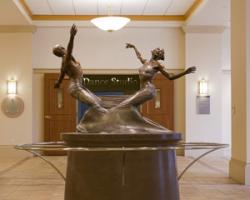Bronze Age Chinese vessels from one of the finest old English collections, formed by the 2nd Lord Cunliffe between the darkest war years of the early 1940s, and his death in 1963, achieved astonishing prices at Bonhams sale of Chinese Art on, November 5, in London.
 The most important group of early Chinese bronzes ever offered at Bonhams, the Collection mainly comprised classic funerary vessel dating from the 12th to 2nd century BC. The auction achieved a total of £4.936,300 and the Cunliffe items in the sale went like fireworks, appropriately enough given the date – November 5.
The most important group of early Chinese bronzes ever offered at Bonhams, the Collection mainly comprised classic funerary vessel dating from the 12th to 2nd century BC. The auction achieved a total of £4.936,300 and the Cunliffe items in the sale went like fireworks, appropriately enough given the date – November 5.
In a packed saleroom bronze and other objects achieved more than 10 times their pre-sale estimates. Lot 8 – the luckiest number in Chinese numerology – an archaic bronze inscribed ritual food vessel – went for no less than £490,400 against a pre-sale estimate of £40,000 to £60,000. Lot 3, an archaic bronze ritual wine vessel estimated at £20,000 to £30,000 sold for £378,400. And an Imperial white jade’double dragon’ seal sold for £305,600 against an estimate of £20,000 to £30,000.
Colin Sheaf, Head of Asian Art at Bonhams, and the company’s Deputy Chairman, said after the sale: “The message we heard today from Asian Art collectors is that the recession is officially over as far as Chinese art collectors are concerned. The sale proves one of the great truths of auctioneering, that the best and rarest items hold and exceed their value even in bad times. It has been a great pleasure to take a sale that so rousingly endorses the strength of the Asian Art market.”
English collectors were among the most prominent Western collectors of Chinese art in the mid 20th century, but very few collections formed at that time remain in private hands, as did the Cunliffe Collection.
Wing Commander Lord Cunliffe’s son, Roger, the 3rd Lord Cunliffe, says of his father’s collecting during the war: “There weren’t many people buying fragile porcelain as the flying bombs rained down. What makes this even more extraordinary is the fact that he lived in a top floor flat in London’s West End. A countryman at heart my father always had his city suits made with a poacher’s pocket. How better to discreetly bring home a Palace bowl?”
The Bonhams sale of the Cunliffe will draw international interest from private and museum buyers, attracted to exhibited and published bronzes which have remained unseen in private hands for over fifty years. Given the international restrictions of selling archaeological treasures (like outstanding bronzes) whose origins are undocumented, the excellent old pedigree of this famous English collection will encourage public bodies to bid and buy, confident that the date of original acquisition in London falls well outside the restricted decades.
The 2nd Baron Cunliffe (1899 1963) was fortunate to be buying in London when fine Chinese material was being offered for sale week after week at auction and by dealers, and Asian buyers were not yet the purchasing force that they have now become. Great fellow collectors had included George Eumorfopoulos, Sir Percival David, Mrs Sedgwick and Oscar Raphael, many of whose collections subsequently entered national museums.
During his lifetime, Lord Cunliffe’s acquisitions were available for enthusiasts to study in his spacious flat across Carlos Place from the Connaught Hotel, conveniently placed for buying trips at London’s major Chinese ceramics dealers, Bluetts, Sparks, Spinks and Peter Boode. In 1923, the foundation of the Oriental Ceramic Society had given English collectors a unique forum in which information could be disseminated, opinions canvasses and exhibitions held. Many Cunliffe items, including selections from the bronzes, were generously loaned to the Society’s ground-breaking exhibitions during the 1940s and 50s. The Collection to be offered in November is particularly striking because of the rarity and outstanding condition of the bronzes to be offered.
Imperial white jade ‘double-dragon’ seal sells for £305,600.
The wise words – ‘Love your people as you would your own children’ – on the seal of a Chinese Emperor who ruled a century ago were not enough to save his reign during the Boxer Rebellion around 1900.
The Imperial white jade double-dragon seal was estimated to sell for £100,000 to £150,000 at Bonhams sale of Fine Chinese Art in New Bond Street on 5th November during Asian Art week in London bit In the event it went for a massive £305,600.
Asaph Hyman, Senior Specialist in Chinese Art at Bonhams, comments: “Once in a while an object of unique Imperial Chinese importance emerges which causes one to catch one’s breath, holding in one’s hands a personal object used by an Emperor that exceptionally captures his love for his people as shown in his attempt at reform. It is a great privilege to be selling such an extraordinary, fine and rare seal.”
The use of such a benevolent message on his seal seems appropriate for the young ruler of a country determined to introduce reform presented by Imperial initiative. But such benevolence was in vain.
The short reign of the Guangxu Emperor was witness to one of the most disruptive periods in the dynasty. Increased and intensified imperialist expansion led to the growth of the nationalist group, Boxers United in Righteousness, who by 1900 were openly attacking, and sometimes killing, Chinese converts and those who possessed foreign objects, as well as foreigners themselves. This attack came to a climax at the siege of the Legations.
www.bonhams.com/asian



